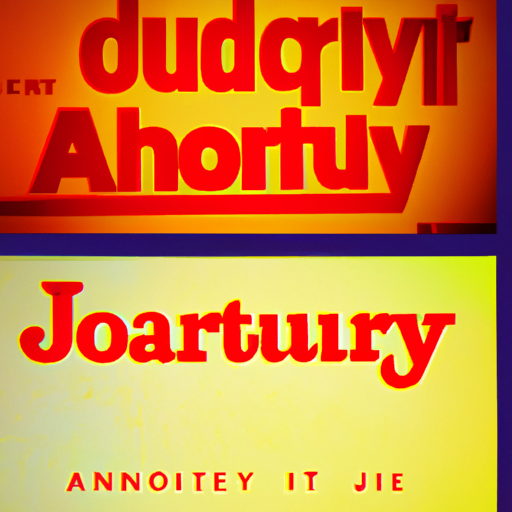
-
Table of Contents
- Designing Custom Fonts: A Journey into Typography Creation
- The Importance of Custom Fonts
- The Process of Designing Custom Fonts
- 1. Research and Conceptualization
- 2. Letterform Design
- 3. Digitization and Software Tools
- 4. Testing and Refinement
- 5. Production and Distribution
- Case Studies: Successful Custom Font Designs
- 1. Airbnb Cereal
- 2. Coca-Cola Spencerian Script
- 3. Google Product Sans
- The Challenges of Designing Custom Fonts
Designing Custom Fonts: A Journey into Typography Creation

Typography is an essential element of design that can greatly impact the overall aesthetic and effectiveness of a visual composition. While there are countless fonts available for designers to choose from, sometimes the need arises for a custom font that perfectly aligns with a specific project’s requirements. Designing custom fonts is a fascinating process that involves a deep understanding of typography principles, meticulous attention to detail, and a creative mindset. In this article, we will explore the journey into typography creation, uncovering the steps involved, the challenges faced, and the rewards that come with designing custom fonts.
The Importance of Custom Fonts
Fonts play a crucial role in visual communication. They have the power to evoke emotions, convey messages, and establish brand identities. While there are numerous pre-existing fonts available, using a custom font can provide several advantages:
- Uniqueness: Custom fonts allow designers to create a distinct visual identity for their projects. By crafting a font specifically tailored to the brand or message, designers can ensure that their work stands out from the crowd.
- Consistency: Custom fonts enable designers to maintain consistency across various design elements. By using a custom font, designers can ensure that the typography aligns seamlessly with the overall design, creating a cohesive and harmonious visual experience.
- Brand Identity: Custom fonts can become an integral part of a brand’s identity. They can reinforce brand values, evoke specific emotions, and establish a recognizable visual language that resonates with the target audience.
The Process of Designing Custom Fonts
Designing a custom font is a complex and time-consuming process that requires a combination of technical skills and artistic sensibility. Let’s explore the key steps involved in creating a custom font:
1. Research and Conceptualization
Before diving into the design process, it is crucial to conduct thorough research and gather inspiration. Understanding the project’s requirements, target audience, and desired tone is essential. This research phase helps designers gain insights into the visual direction and style that the custom font should embody.
Once the research is complete, designers move on to the conceptualization stage. This involves sketching initial ideas, exploring different letterforms, and experimenting with various styles. It is important to strike a balance between creativity and functionality, ensuring that the custom font remains legible and usable.
2. Letterform Design
The next step in the process is designing the individual letterforms that make up the custom font. This involves creating each letter, number, and symbol from scratch, paying close attention to proportions, curves, and spacing. Designers must consider the overall visual harmony of the font, ensuring that each character complements the others.
During this stage, designers may also experiment with different weights, styles, and variations to create a versatile font family that can be used in various contexts.
3. Digitization and Software Tools
Once the letterforms are designed, they need to be digitized using specialized software tools. Designers can choose from a variety of font editing software, such as Glyphs, FontLab, or Adobe Illustrator. These tools allow designers to refine the letterforms, adjust curves, and fine-tune the spacing and kerning.
Digitization also involves assigning Unicode values to each character, which ensures compatibility across different devices and platforms. Additionally, designers can add OpenType features, such as ligatures or alternate glyphs, to enhance the functionality and versatility of the custom font.
4. Testing and Refinement
Once the initial digitization is complete, it is crucial to test the custom font extensively. Designers should evaluate its legibility, readability, and overall visual impact in different sizes and contexts. This testing phase helps identify any issues or inconsistencies that need to be addressed.
Based on the feedback gathered during testing, designers refine the font, making necessary adjustments to improve its overall quality. This iterative process may involve tweaking letterforms, adjusting spacing, or refining curves to ensure optimal legibility and visual appeal.
5. Production and Distribution
After the testing and refinement phase, the custom font is ready for production and distribution. Designers can export the font files in various formats, such as TrueType or OpenType, to ensure compatibility with different operating systems and design software.
Custom fonts can be distributed through various channels, such as online font marketplaces or direct licensing to clients. Designers may also consider offering the custom font as part of a larger typeface family, providing additional options and variations to users.
Case Studies: Successful Custom Font Designs
Let’s explore a few case studies of successful custom font designs that have made a significant impact:
1. Airbnb Cereal
Airbnb, the popular online marketplace for accommodations, wanted to revamp its visual identity to reflect its evolving brand values. They collaborated with the type foundry Dalton Maag to create a custom font called “Cereal.” The font embodies Airbnb’s friendly and inclusive brand personality while maintaining excellent legibility across various platforms and languages.
2. Coca-Cola Spencerian Script
The Coca-Cola Company is known for its iconic logo and distinctive typography. The company’s custom font, known as “Coca-Cola Spencerian Script,” is based on the original handwriting of Frank M. Robinson, the company’s co-founder. This custom font has become synonymous with the brand and is instantly recognizable worldwide.
3. Google Product Sans
Google’s custom font, “Product Sans,” was designed to align with the company’s clean and minimalist design principles. The font is used across various Google products and services, providing a consistent and recognizable visual identity. Its simplicity and legibility make it suitable for both digital and print applications.
The Challenges of Designing Custom Fonts
While designing custom fonts can be a rewarding process, it also comes with its fair share of challenges. Here are some common hurdles that designers may encounter:
- Technical Complexity: Designing custom fonts requires a deep understanding of typography principles, software tools, and font file formats. It can be a technically complex process, especially for designers who are new to typography creation.
- Time-Consuming: Creating a custom font is a time-consuming endeavor that demands meticulous attention to detail. From initial research to final refinement, the process can take weeks or even months, depending on the complexity of the font.
- Legibility and Readability: Ensuring optimal legibility and readability is a significant challenge in custom font design. Designers must strike a balance between creativity and functionality, ensuring that the font remains usable across different sizes, platforms, and languages
